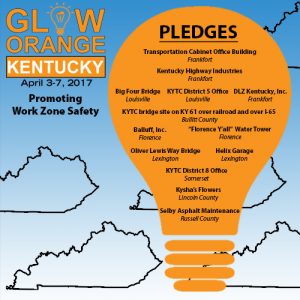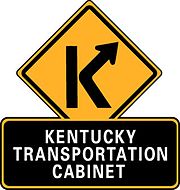
2017 “Glow Orange, Kentucky!” Pledge Map
Focusing on the human aspect surrounding highway work zone safety, the Kentucky Transportation Cabinet (KYTC) launched its state work zone safety campaign this week in conjunction with National Work Zone Awareness Week (NWZAW), April 3-7. The 2017 national theme – Work Zone Safety Is In Your Hands – reinforces the message that work zone safety is a shared responsibility for work crew members and motorists.
“Kentucky transportation road crews risk their lives daily to build and maintain bridges and roads across the Commonwealth so that we all can connect with people and places that are important to us,” said Gov. Matt Bevin. “As a young man, I worked for a state highway department and know about the dangers presented to men and women doing their jobs in highway work zones. These public servants are fathers, husbands, brothers, daughters and friends. Let’s all do our part to take precautions to make sure these highway workers – real people with real lives – get home safely each night.”
With roadway construction season kicking off in April across Kentucky, many motorists will encounter at least one work zone in their daily commute. Although highway work zones are high-risk sites for crew members, the lives of drivers and their passengers are also on the line in a work zone. In fact, Federal Highway Administration statistics indicate that motorists, not workers, are more at risk in a work zone. In a typical five-day work week, an average of seven motorists and one worker are killed around the nation in work zones. To help spread awareness, Gov. Bevin signed a proclamation declaring April Work Zone Safety Month in Kentucky.
Real stories, real people
Last year, there were 674 work zone related crashes, 143 injuries and 10 fatalities in Kentucky. To increase awareness of work zone safety and the lives affected by preventable accidents, KYTC asked the public to support this year’s campaign through sharing work zone stories. Retellings of near misses while working, losing loved ones in work zones and observations of negligent driving behavior were featured in several submissions. Each story stressed the risk of working in a work zone and the lives at stake.
“When he died, a piece of me died also – a void that you can’t replace,” wrote Tonya Ashby about her brother Kendale T. Ashby, who was hit by a car in 2014 while working in an active highway work zone.
Kendale Ashby was a father of four, a husband, a brother and a best friend.
“The Cabinet is grateful for public support in the form of personal stories and pledges from public and private partners to ‘Glow Orange’ to promote work zone awareness,” said KYTC Secretary Greg Thomas. “The safety of our road crews and of motorists in work zones is in each of our hands.”
Orange hues in the Bluegrass
Another element of KYTC’s 2017 work zone awareness campaign is “Glow Orange, Kentucky” week, an initiative inspired by the national “Go Orange Day,” which also promotes work zone awareness. KYTC has invited organizations and citizens throughout the Commonwealth to illuminate buildings, landmarks, bridges, structures and homes with the color orange to show support during the week of April 3-7.
The Cabinet encourages the public to submit “Glow Orange, Kentucky” safety selfies taken in front of illuminated structures to Facebook and Twitter using #glowky. Businesses and agencies that have pledged to “Glow Orange” are featured on KYTC’s social media pages.
Lives in your hands
For the protection of all lives in work zones, KYTC asks drivers to practice 10 work zone safety tips:
1. Pay attention – put away the phone.
2. Respect the posted speed limits – even if workers do not appear to be present.
3. Don’t tailgate.
4. Keep a safe distance from workers and equipment.
5. Expect the unexpected.
6. Obey road crew flaggers.
7. Allow extra time to get to your destination if traveling through a work zone.
8. Keep up with traffic flow.
9. Before leaving home or work, check out goky.ky.gov or use the free WAZE app for traffic information.
10. Be patient and remain calm. Construction crews are working to make the roads better for you.
Although Cabinet engineers and contractors schedule work to minimize delays and crashes, the responsibility to drive cautiously through a work zone lies with motorists.
To read work zone stories and stay current with KYTC’s 2017 work zone awareness campaign, connect with the Cabinet at www.facebook.com/kytc120/ and https://twitter.com/KYTC and follow the #inyourhandsky and #glowky discussions. The Cabinet will post related information to social media throughout the month of April.
70-mile section of the Natcher Parkway to eventually become an interstate spur
 Gov. Matt Bevin and U.S. Rep. Brett Guthrie today announced plans to designate a 70-mile section of the William H. Natcher Parkway from Bowling Green to Owensboro as the “Future Interstate 65 Spur.”
Gov. Matt Bevin and U.S. Rep. Brett Guthrie today announced plans to designate a 70-mile section of the William H. Natcher Parkway from Bowling Green to Owensboro as the “Future Interstate 65 Spur.”
The partnership between federal and state officials to upgrade the Natcher Parkway to an interstate spur was forged during a sign unveiling ceremony at the Owensboro Riverport this afternoon.
“Today, we stand firm behind our commitment of unlocking the infinite economic potential that this spur will have. Not only will it attract key investors to Western Kentucky, but it will improve the commute for motorists across the region,” said Gov. Bevin. “From its inception, Congressman Guthrie has championed this project each step of the way. I applaud his diligent efforts as well as our federal and state partners to help secure the necessary funding to begin the process.”
The designation of an interstate spur elevates the prominence of a highway into a federally-recognized corridor. In turn, businesses and other entities look to locate along a major federal thoroughfare. In addition, upgrading the parkway to interstate standards enhances the safety and mobility of the route.
“Nearly two years ago I joined state and local leaders to discuss a path forward for the Natcher Parkway and the designation as a future I-65 spur was a top priority for me in the latest highway bill. I am pleased to see that today we are one step closer to making this designation a reality and I look forward to the opportunities that it will create for Western Kentucky,” said U.S. Rep. Brett Guthrie, of Bowling Green.
On Aug. 2, the Federal Highway Administration (FHWA) approved the Kentucky Transportation Cabinet’s (KYTC) plan to designate the Natcher Parkway as a future interstate spur. A future agreement between FHWA and KYTC will identify and outline the requirements needed to upgrade the parkway to interstate standards.
The work will include upgrading bridge rails and guardrails; improving exit and entrance ramps; constructing new and/or modifying existing interchanges; and raising some overpass bridges to increase vertical clearance. Continue reading
Hunter brings vast leadership and government experience to KYTC
 Kentucky Transportation Cabinet (KYTC) Secretary Greg Thomas today announced the appointment of Dr. Noelle Hunter as Executive Director of the Kentucky Office of Highway Safety (KOHS).
Kentucky Transportation Cabinet (KYTC) Secretary Greg Thomas today announced the appointment of Dr. Noelle Hunter as Executive Director of the Kentucky Office of Highway Safety (KOHS).
“Dr. Hunter brings a vast wealth of knowledge and life experience to the KOHS,” said Sec. Thomas. “Combined with her passion and dedication to helping others, we believe she is a true asset to the Cabinet.”
The KOHS is responsible for providing traffic safety grant funding to law enforcement agencies and educational programs to schools and communities in an effort to reduce crashes, injuries and fatalities on Kentucky roadways.
Prior to joining the KYTC, Hunter was the Director of College Readiness and an instructor of Developmental Reading at Morehead State University. During her decade in higher education, Hunter served as a professor of state and local government, American political institutions and international relations at Morehead State, West Virginia University and West Virginia Wesleyan University.
In 2014, Hunter testified before the U.S. Senate Committee on Foreign Relations on the problem of international parental child abduction. Hunter successfully recovered her daughter from abduction to Mali that same year with support and resources from her home community of Morehead, her native state of Alabama, and from Congress, the U.S. Department of State and the U.S. Department of Justice. Hunter co-founded iStand Parent Network Inc. to empower parents to return their children from abduction and currently serves as president of the board of directors.
In 2003, Hunter served as the James E. Webb Fellow for the Smithsonian Institution Office of Policy and Analysis and worked in constituent services for the former Sen. Jay Rockefeller, of West Virginia. Prior to federal service, Hunter was the Walter Rollins Scholar for the West Virginia Legislature Committee on Health and Human Services and committee staff for the subcommittees on Homeland Security and Bioterrorism; and Workforce, Innovation and the New Economy—responsible for identifying threats and contingency plans to protect West Virginia’s critical infrastructure.
Hunter worked as a media relations executive for Public Communications, Inc. in Chicago and coordinated learning opportunities for underserved, urban youth from 1995-2000.
“The essence of the KOHS mission is to help people live as they travel our beautiful Commonwealth,” said Hunter. “It’s a great privilege to work in a Cabinet where this is our focus.”
Hunter earned a Bachelor of Science degree in journalism in 1994 and a Masters of Public Administration in 2009 from Ohio University. She earned her Ph.D. in Political Science from West Virginia University in 2007.
Hunter has lived in Kentucky for 11 years and has three daughters, Rachel, Rysa and Muna.
“Pause-50” plan aims to restore funding back to normal operating levels
 Kentucky Transportation Cabinet (KYTC) Secretary Greg Thomas today testified before the Interim Joint Committee on Transportation about the condition of the Road Fund cash balance—the funding source for all Cabinet operations including construction, maintenance and general support.
Kentucky Transportation Cabinet (KYTC) Secretary Greg Thomas today testified before the Interim Joint Committee on Transportation about the condition of the Road Fund cash balance—the funding source for all Cabinet operations including construction, maintenance and general support.
In his testimony, Sec. Thomas detailed the seriousness of a low Road Fund cash balance and introduced the Cabinet’s “Pause-50” plan to restore funding back to normal operating levels.
“For the first time in recent history, the Cabinet faces a low Road Fund cash balance, which compromises our ability to authorize new state road projects over the next biennium,” said Sec. Thomas. “The “Pause-50” approach is designed to slow or delay the starts of new projects so that we can pay current expenditures, recoup lost revenue and rebuild our funding base.”
Based on the KYTC’s cash management plan, the Cabinet strives to have a balance of at least $100 million at any given time. The last time the cash balance neared zero was in 2004 when it hit $30 million.
Consequently, the Cabinet will implement the “Pause-50” plan by halting the starts of new state-funded projects in all phases, which includes design, right of way/utilities, and construction for the first year of the biennium; and in the second year, aim for a goal of $50 million to allocate on state-funded projects starts.
In essence, the Cabinet will “pause” adding new state-funded projects for the first year in the biennium. For the second year, the Cabinet anticipates the availability of $50 million for state-funded projects starts. The dollar amount could be higher or lower depending on actual expenditures of current projects and the flow of state revenue funding.
In March, Sec. Thomas gave legislators a brief overview of the situation and identified several critical factors that have contributed to the low cash balance—mainly, overspending with limited funds.
State spending has greatly exceeded revenues since Fiscal Year 2014. Road Fund revenues totaled $4.5 billion over FY 2014-2016. Over the same period, expenses totaled $5.035 billion, exceeding revenues by $498 million; meaning that the start of new state funded projects must be delayed in order to meet payment of current expenditures as well as restoring the $100 million cash balance threshold. Continue reading
 Weather
Weather Traffic
Traffic @LouisvilleDispatch
@LouisvilleDispatch @LouisvilleDisp
@LouisvilleDisp Subscribe
Subscribe